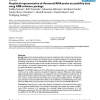Free Online Productivity Tools
i2Speak
i2Symbol
i2OCR
iTex2Img
iWeb2Print
iWeb2Shot
i2Type
iPdf2Split
iPdf2Merge
i2Bopomofo
i2Arabic
i2Style
i2Image
i2PDF
iLatex2Rtf
Sci2ools
BMCBI
2005
2005
Graphical representation of ribosomal RNA probe accessibility data using ARB software package
Background: Taxon specific hybridization probes in combination with a variety of commonly used hybridization formats nowadays are standard tools in microbial identification. A frequently applied technology, fluorescence in situ hybridization (FISH), besides single cell identification, allows the localization and functional studies of the microbial community composition. Careful in silico design and evaluation of potential oligonucleotide probe targets is therefore crucial for performing successful hybridization experiments. Results: The PROBE Design tools of the ARB software package take into consideration several criteria such as number, position and quality of diagnostic sequence differences while designing oligonucleotide probes. Additionally, new visualization tools were developed to enable the user to easily examine further sequence associated criteria such as higher order structure, conservation, G+C content, transition-transversion profiles and in situ target accessibility patt...
| Added | 15 Dec 2010 |
| Updated | 15 Dec 2010 |
| Type | Journal |
| Year | 2005 |
| Where | BMCBI |
| Authors | Yadhu Kumar, Ralf Westram, Sebastian Behrens, Bernhard Fuchs, Frank Oliver Glöckner, Rudolf Amann, Harald Meier, Wolfgang Ludwig |
Comments (0)

